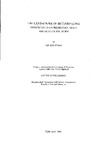THE LANDSCAPES OF RICHARD LONG: PERSPECTIVES ON PREHISTORY, SPACE AND SCULPTURAL FORM
| dc.contributor.author | WIGHTMAN, IAN | |
| dc.contributor.other | Faculty of Arts, Humanities and Business | en_US |
| dc.date.accessioned | 2013-10-28T10:55:47Z | |
| dc.date.available | 2013-10-28T10:55:47Z | |
| dc.date.issued | 1999 | |
| dc.identifier | NOT AVAILABLE | en_US |
| dc.identifier.uri | http://hdl.handle.net/10026.1/2405 | |
| dc.description.abstract |
This thesis examines the relationship between the work of Richard Long and prehistory. This is understood to operate at two levels. Firstly, Long's critical reception has repeatedly made connections between his work and prehistory, many of which are overly simplistic. Secondly, and underlying this response, it is proposed that we can point to a more productive understanding of Long's practice which frames his work within the concept of existential space. At this level of enquiry, more appropriate connections with prehistory can be made which help to explain both his working practice and the critical reactions to it. Chapter I, 'Introduction to Methodology', describes aims and objectives and locates the analyses in relation to the theoretical positions which are to be taken. Chapter II, 'Walking the Line: From Abstraction to Reality', establishes the trajectory of the research through an analysis of two contextual frameworks (20th century British art and prehistory and Land Art and prehistory) and identifies Long's practice with regards to specific transitions in sculptural activity. Chapter III, 'Mapping the Field of Possibilities: An Analytical Reading of the Critical Discourse', examines interpretative tendencies within Long's critical reception. It defines the extent and nature of his work's perceived correspondence with the ancient past and exposes certain phenomenological perspectives as a means for formulating further analyses. Chapter IV, 'Where the Walk Meets the Place: Archaeology and Technologies of the Self', reveals the role Long's art plays within archaeological discourse as a means for understanding megalithic monuments and correlates his practice with some philosophical approaches employed in archaeology. Chapter V, 'The Architecture of Sculpture: Existential Space and Being-in-the-World', furthers the concerns of earlier chapters by analysing Long's art through the concept of existential space to describe its spatial operation in the environment. This translates Long's landscape sculptures from abstract art into perceptual schemata, implicating them in the assimilation of environments. This has particular consequences for his art: by demonstrating its sculptural significance to the structuration of space, it offers the work as an equivalent to prehistoric structures. Chapter VI, 'Conclusion'. | en_US |
| dc.language.iso | en | en_US |
| dc.publisher | University of Plymouth | en_US |
| dc.title | THE LANDSCAPES OF RICHARD LONG: PERSPECTIVES ON PREHISTORY, SPACE AND SCULPTURAL FORM | en_US |
| dc.type | Thesis | |
| dc.identifier.doi | http://dx.doi.org/10.24382/3846 |
Files in this item
This item appears in the following Collection(s)
-
01 Research Theses Main Collection
Research Theses Main


